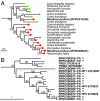Genome of Rhodnius prolixus, an insect vector of Chagas disease, reveals unique adaptations to hematophagy and parasite infection
- PMID: 26627243
- PMCID: PMC4672799
- DOI: 10.1073/pnas.1506226112
Genome of Rhodnius prolixus, an insect vector of Chagas disease, reveals unique adaptations to hematophagy and parasite infection
Erratum in
-
Correction for Mesquita et al., Genome of Rhodnius prolixus, an insect vector of Chagas disease, reveals unique adaptations to hematophagy and parasite infection.Proc Natl Acad Sci U S A. 2016 Mar 8;113(10):E1415-6. doi: 10.1073/pnas.1600205113. Epub 2016 Feb 29. Proc Natl Acad Sci U S A. 2016. PMID: 26929356 Free PMC article. No abstract available.
Abstract
Rhodnius prolixus not only has served as a model organism for the study of insect physiology, but also is a major vector of Chagas disease, an illness that affects approximately seven million people worldwide. We sequenced the genome of R. prolixus, generated assembled sequences covering 95% of the genome (∼ 702 Mb), including 15,456 putative protein-coding genes, and completed comprehensive genomic analyses of this obligate blood-feeding insect. Although immune-deficiency (IMD)-mediated immune responses were observed, R. prolixus putatively lacks key components of the IMD pathway, suggesting a reorganization of the canonical immune signaling network. Although both Toll and IMD effectors controlled intestinal microbiota, neither affected Trypanosoma cruzi, the causal agent of Chagas disease, implying the existence of evasion or tolerance mechanisms. R. prolixus has experienced an extensive loss of selenoprotein genes, with its repertoire reduced to only two proteins, one of which is a selenocysteine-based glutathione peroxidase, the first found in insects. The genome contained actively transcribed, horizontally transferred genes from Wolbachia sp., which showed evidence of codon use evolution toward the insect use pattern. Comparative protein analyses revealed many lineage-specific expansions and putative gene absences in R. prolixus, including tandem expansions of genes related to chemoreception, feeding, and digestion that possibly contributed to the evolution of a blood-feeding lifestyle. The genome assembly and these associated analyses provide critical information on the physiology and evolution of this important vector species and should be instrumental for the development of innovative disease control methods.
Keywords: Chagas disease; Rhodnius prolixus; genome; hematophagy; immunity.
Conflict of interest statement
The authors declare no conflict of interest.
Figures



References
-
- Wigglesworth VB. The physiology of excretion in a blood-sucking insect, Rhodnius prolixus (Hemiptera, Reduviidae) I. Composition of the urine. J Exp Biol. 1931;8(4):411–427.
-
- WHO . Chagas Disease Fact Sheet No 340. WHO; Geneva: 2015.
-
- Panzera F, et al. Cytogenetics and genome evolution in the subfamily Triatominae (Hemiptera, Reduviidae) Cytogenet Genome Res. 2010;128(1-3):77–87. - PubMed
-
- DeSalle R, Gregory TR, Johnston JS. Preparation of samples for comparative studies of arthropod chromosomes: Visualization, in situ hybridization, and genome size estimation. Methods Enzymol. 2005;395:460–488. - PubMed
Publication types
MeSH terms
Associated data
Grants and funding
LinkOut - more resources
Full Text Sources
Other Literature Sources
Medical
Molecular Biology Databases
Miscellaneous

